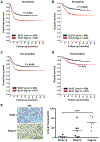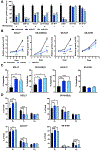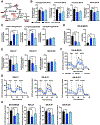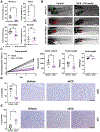Metabolic Enzyme DLST Promotes Tumor Aggression and Reveals a Vulnerability to OXPHOS Inhibition in High-Risk Neuroblastoma
- PMID: 34233924
- PMCID: PMC8577318
- DOI: 10.1158/0008-5472.CAN-20-2153
Metabolic Enzyme DLST Promotes Tumor Aggression and Reveals a Vulnerability to OXPHOS Inhibition in High-Risk Neuroblastoma
Abstract
High-risk neuroblastoma remains therapeutically challenging to treat, and the mechanisms promoting disease aggression are poorly understood. Here, we show that elevated expression of dihydrolipoamide S-succinyltransferase (DLST) predicts poor treatment outcome and aggressive disease in patients with neuroblastoma. DLST is an E2 component of the α-ketoglutarate (αKG) dehydrogenase complex, which governs the entry of glutamine into the tricarboxylic acid cycle (TCA) for oxidative decarboxylation. During this irreversible step, αKG is converted into succinyl-CoA, producing NADH for oxidative phosphorylation (OXPHOS). Utilizing a zebrafish model of MYCN-driven neuroblastoma, we demonstrate that even modest increases in DLST expression promote tumor aggression, while monoallelic dlst loss impedes disease initiation and progression. DLST depletion in human MYCN-amplified neuroblastoma cells minimally affected glutamine anaplerosis and did not alter TCA cycle metabolites other than αKG. However, DLST loss significantly suppressed NADH production and impaired OXPHOS, leading to growth arrest and apoptosis of neuroblastoma cells. In addition, multiple inhibitors targeting the electron transport chain, including the potent IACS-010759 that is currently in clinical testing for other cancers, efficiently reduced neuroblastoma proliferation in vitro. IACS-010759 also suppressed tumor growth in zebrafish and mouse xenograft models of high-risk neuroblastoma. Together, these results demonstrate that DLST promotes neuroblastoma aggression and unveils OXPHOS as an essential contributor to high-risk neuroblastoma. SIGNIFICANCE: These findings demonstrate a novel role for DLST in neuroblastoma aggression and identify the OXPHOS inhibitor IACS-010759 as a potential therapeutic strategy for this deadly disease.
©2021 American Association for Cancer Research.
Figures







References
-
- Brodeur GM. Neuroblastoma: biological insights into a clinical enigma. Nat Rev Cancer 2003;3:203–16. - PubMed
-
- Park JR, Bagatell R, London WB, Maris JM, Cohn SL, Mattay KM, et al. Children’s Oncology Group’s 2013 blueprint for research: Neuroblastoma. Pediatr Blood Cancer 2013;60:985–93. - PubMed
-
- Maris JM, Hogarty MD, Bagatell R, Cohn SL. Neuroblastoma seminar. Lancet 2007;369:2106–20. - PubMed
Publication types
MeSH terms
Substances
Grants and funding
LinkOut - more resources
Full Text Sources
Medical
Molecular Biology Databases

